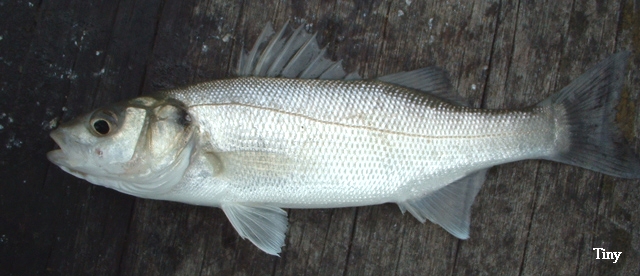Identification:
This fish has an elongated and streamlined body, with two separately spaced
dorsal fins. The first, or anterior dorsal fin, is composed of 8 to 9 membrane
bound bony spines. The second dorsal fin has a leading spine, followed by
12 to 13 soft branched rays. The anal fin has 3 leading spines and 10 to
12 soft branched rays. The anal fin is set slightly back from the front of
the second dorsal fin, which it sits beneath. The pectoral fins are positioned
ahead of the pelvic fins, which are located at the anterior portion of the
belly. The head is slightly enlarged, with a large wide mouth, although the
eyes are relatively small in relation to head length. Opercular and preopercular
bones have spines. Body and head are covered in large scales.Back is a bluish
grey that blends into the metallic silver grey of the sides, and silver/greyish
white of the belly. the gill cover has a darkish blotch towards it's posterior
margin.
Breeding:
Spawns inshore during March through to June. The juveniles are
pelagic, but rapidly enter estuaries, where they remain for the first few
years. Growth rates are slow, with lengths of 9cm in the first year for
the female, then to 16cm in the second, and almost five years for a
female bass to reach 32 to 36cm, when they are sexually mature. A female
bass of 10lb maybe 16 to 20 years old. The males grow more slowly, and
don't live as long as the females.
Habitat:
Schooling predatory fish, associated with warm coastal waters, reefs, estuaries,
as well as, over sand and mud, down to depths of 100m.Larger fish tend to
be more solitary, than the smaller school bass of 4lb or less. Inshore migration
during March through to may, often into brackish water.
Food:
Tends to be a surface water predator, feeding on a wide range of other
fish, such as sandeels, herring, sprat, pouting, etc., along with a variety
of crustaceans such as crab and shrimp. Tend to hunt in disturbed water i.e.
breakers and close to rock faces.
Range:
Found throughout the waters of the U.K.,
although most numerous in the South and West.
Additional Notes:
Commercially trawled. Good eating. |


